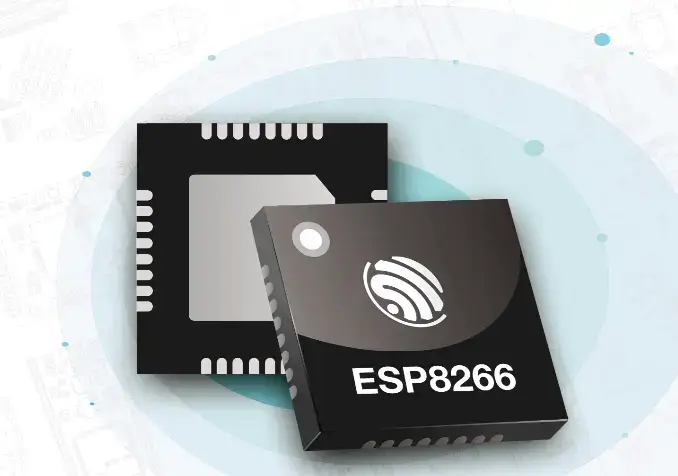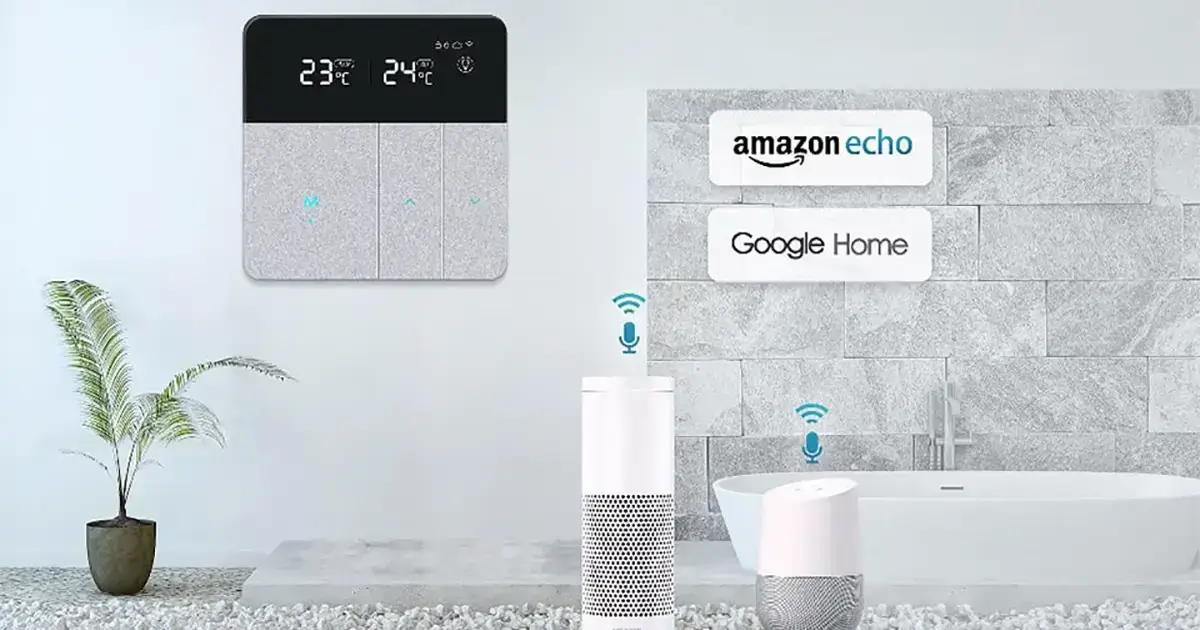The WiFi thermostat is a product developed with the Internet of Things. Before 2009, people didn’t even know what a WiFi thermostat was. In 2003, the American Technology Review magazine proposed that sensor network technology will be the top 1 technology that will change people’s lives in the future. After that, there is a boom in IoT devices throughout the world, WiFi thermostat is one of them.
Here, eBee Technology introduces you to what is a WiFi thermostat.
On This Post, You Will Learn the below Contents
- the Development of WiFi Thermostat
- the Components of WiFi Thermostat
- What Are the Functions of the WiFi Thermostat
- the Main Markets and Prices of WiFi Thermostats
- the Advantages of WiFi Thermostat, Compared with Bluetooth and Zigbee Technology
- the Expansion of the WiFi Thermostat
the Development of WiFi Thermostat
In the HVAC field(Heating, Ventilation and Air Conditioning), thermostats are mainly used for temperature adjustment of boiler heating, floor heating (electric heating and plumbing), central air conditioning systems, and air source air conditioning systems. People invented thermostats and temperature sensors due to the need for temperature control and management. In the 1830s, Scottish chemist Andrew Ure developed the first room thermostat. After that, new models continued to appear, but the early thermostats and sensors were mechanical. In 1885, Johnson Controls developed an electronic thermostat.
Since then, there has been no greater breakthrough in the function of the thermostat, and manufacturers have only played in the appearance design.
With the development of the communication industry and the electronics industry, in the 2000s, many types of WiFi modules have appeared on the market. Among them, embedded WiFi modules suitable for smart homes are also common, and WiFi communication standards are relatively mature. The Internet of Things began to rise under such technical conditions.
In May 2014, ESPRESSIF released the first ultra-low power consumption, highly integrated IoT chip ESP8266, making smart home products a qualitative leap in price, compatibility, and configuration. The original WiFi SoC cost was 30-60 RMB. After adopting the ESP8266 solution, the overall cost has dropped by 10 RMB and even has a price of 12.5 RMB. At the end of 2017, Chinese thermostat manufacturers began to use Tuya, BroadLink and other companies’ WiFi IoT solutions to upgrade thermostats.

In 2018, there are already several mature WiFi thermostats on the market, and China’s WiFi thermostat suppliers are extremely cost-effective. In the same year, the WiFi thermostat supplied by eBee Technology won the Red Dot Design Award.
As a part of the smart home, WiFi thermostat plays a great role in the convenience of HVAC regulation. The future development direction, in addition to the optimization of the underlying technology and user experience, there is also the collaborative development of the entire smart home system. Let us look forward to the surprises that WiFi thermostats can bring in the future!
The Components of WiFi Thermostat
At present, manufacturers of WiFi thermostats have basically abandoned the past scale panels and adopted electronic displays. According to the operation mode of the WiFi thermostat panel, WiFi thermostats can be divided into touch screen WiFi thermostats, physical button WiFi thermostats, and knob-type thermostats. In addition to the different control components, these three types of thermostats all include the main parts of the sensor, display panel, mounting panel, and internal circuit components.
The temperature sensor monitors and samples the temperature of the target environment in real-time, and transmits the collected temperature to the thermostat in the form of physical deformation or electronic signal. The thermostat judges the collected temperature signals referring to the configured values and outputs signals to slave actuators. For example, in a boiler heating system, the temperature sensor detects the temperature in the room, and the thermostat controls the on and off of the boiler by dry contact according to the received temperature. If the temperature is too low, the boiler will be kept on until the temperature reaches a predetermined value.
| Types of Temperature Sensor | Working Principle |
|---|---|
| Metal Expansion Sensor | After the environmental temperature changes, the physical properties of the metal itself will change accordingly, the shape will be extended, and then the temperature change will be reflected. |
| Bimetallic Sensor | Two metal sheets with different expansion coefficients are pasted together. When the temperature changes, the different expansion degrees of the two metals cause the metal to bend, and the curvature of the bending can be converted into a signal output. |
| Bimetal Rod and Metal Tube Sensor | When the temperature changes, the physical shape of the metal tube changes, but the unexpanded steel rod does not change. The relative position of the metal tube and the metal rod changes. This linear change in position can be converted into a signal output. |
| The sensor designed by the deformation curve of liquid and gas | When the temperature changes, liquid and gas will produce volume changes, and through conversion, a temperature change signal output is formed. |
| Resistance Sensor | As the temperature changes, the resistance value of the metal changes accordingly, and the output signal is adjusted accordingly. |
| Thermocouple Sensor | A closed-loop composed of two conductors of different material components, when there is a temperature gradient at both ends, due to the Seebeck effect, an electromotive force will be formed, which will be converted and output as a temperature signal. |
The display panel has three types: color display, digital tube display and LED display. The WiFi thermostat with colour display has the best display effect, and at the same time has a wealth of functions, even artificial intelligence for autonomous learning, the price is also the highest. The WiFi thermostat with digital tube display continues the configuration of the traditional thermostat, with the difference between positive display and negative display, plus the backlight, it makes people feel very classic! WiFi thermostats with LED displays are often matched with a well-designed frame, which is simple and stylish.
The installation panel reflects the applicable fields of WiFi thermostats, including floor water heating, floor electric heating, boiler heating, central air conditioning and heat pump systems, different systems have different wiring methods. Usually, Chinese manufacturers of WiFi thermostats will design separate installation panels according to these application fields while WiFi thermostat manufacturers in Europe and America prefer to make one thermostat adapt to all HVAC systems. One is single-function but cheaper, and one is powerful but expensive, depending on the user’s choice.
Whether a WiFi thermostat is powerful or not depends largely on the electronic circuits and embedded programs. In the development of the technological level, the charm of industrial design is certainly important, but the functional upgrades brought by integrated circuits are more attractive. In addition to more application scenarios, the powerful WiFi thermostat also has more stable circuit protection.
This is the introduction to the main components of the WiFi thermostat, and more new components may be born in the future.
What Are the Functions of the WiFi Thermostat
As a part of smart home devices, the most important thing about the WiFi thermostat is its functions. Here, eBee Technology introduces the following main functions.
#1 Remotely Control the WiFi Thermostat Via the APP on the Smartphone
The WiFi thermostat communicates with smartphones through WiFi modules, routing networks, and cloud servers. The well-designed interactive interface on the smartphone APP allows users to turn on/off the WiFi thermostat, adjust the temperature of the WiFi thermostat, set the WiFi thermostat operating mode, and set the WiFi thermostat programming function. As long as the smartphone is in hand, you can control the temperature of your home.
#2 Use the Voice Commands to Control WiFi Thermostat
As a new window for information input/output of smart home devices, voice control brings great convenience and liberates people’s hands. Amazon Alexa and Google Home are the two most popular smart voice speakers in the world. Through voice, in addition to controlling all the functions of the WiFi thermostat, you can also combine the functions of the smart speaker to create interesting applications. For example, people can use the timing function of smart speakers to expand the programming mode of a WiFi thermostat.
To learn how to connect a WiFi thermostat to a smart speaker, you can click here: Amazon Alexa User Guide and Google Home Assistant User Guide.
#3 Automatically Count the Usage Data of WiFi Thermostat
During the long-term use of the WiFi thermostat, a large amount of data will be generated, including the user’s permanent temperature, energy consumption, and the use period of the WiFi thermostat, etc. The WiFi thermostat will upload these data to the cloud server, perform analysis and statistics, and feedback to the user’s APP interface to form traceable data. Also, WiFi thermostats can overcome the problems of settings and data loss after power failure. After power is restored, it will automatically download data from the cloud server and update it to the hardware.
#4 WiFi Thermostat Works With Other Smart Devices to Form Usage Scenarios
Binding electrical appliances to the smartphone is the trend of home appliances. There are many integrated platforms, such as Tuya, Xiaomi Mijia/MiHome, Broadlink, Huawei Hilink, etc. Through these platforms, a large number of smart home devices are connected, and real-time interactive operation status. As the control part of HAVC, the WiFi thermostat can be linked with smart switches, smart sockets, and smart kitchen and bathroom products to form a function of application scenarios. For example, when you go home from work at night, you can turn on the “Family Scene” through the voice function. In this scene, the WiFi thermostat will be adjusted to the most comfortable temperature, the lights will automatically turn on, the water heater will be ready to boil water, and the water dispenser automatically soaks a cup of coffee, all you have to do is just enjoy it!
the Main Markets and Prices of WiFi Thermostats
Geographical Distribution of WiFi Thermostat Suppliers
WiFi temperature controller emerged in 2014. Because of its high technical level, strong innovation spirit and leading market development ability, the leading suppliers in the market are mainly in Europe and the United States, including Nest Lab, Honeywell International, Emerson Electric, Control 4 Corporation, Carrier Corporation and Sensi in the United States, Ecobee in Canada and Schneider Electric SE in France, Tado in Germany, etc.
Geographic Distribution of WiFi Thermostat Usage Types
Due to the different climates of different latitudes, in tropical and subtropical areas, the central air conditioning WiFi thermostat is mainly used, and in the northerly areas, the WiFi thermostat is mainly used to control heating. Depending on the different heating principles, WiFi heating thermostat is divided into air source heat pump WiFi thermostat, central air conditioning WiFi thermostat, electric heating cable/film heating WiFi thermostat, boiler heating WiFi thermostat, water heating WiFi thermostat. In the North American market (including the United States, Canada, and Mexico), it mainly consumes air source heat pump WiFi thermostats, in the Middle East market (including Iran, Kuwait, Bahrain, Israel, Qatar, United Arab Emirates, etc.), it mainly consumes central air-conditioning WiFi thermostat, in the European market (including Finland, Sweden, Norway, Denmark, Latvia, Lithuania, Russia, Ukraine, Poland, Hungary, United Kingdom, Ireland, Netherlands, Germany, Belgium, France, Serbia, Greece, Slovenia, Croatia, Italy, Spain, Portugal, etc.), it mainly consumes heating WiFi thermostats and cooling/heating central air-conditioning thermostats. In the Asia-Pacific market (including China, South Korea, Japan, etc.), it mainly consumes central air-conditioning WiFi thermostats and electric heating cable/film WiFi thermostats. In the Australian market (including Australia), WiFi thermostats for central air conditioners are mainly consumed.
Which Buildings Are Suitable for WiFi Thermostat
In market applications, WiFi thermostats are mainly used in homes, office buildings, villas, hotels, and hospitals.
the Prices of WiFi Thermostat
WiFi thermostat suppliers can be divided into three echelons: European and American technology company brands, European and American traditional HVAC brands, and Southeast Asian manufacturers.
In terms of price, European and American technology companies, such as Nest, Ecobee, and Tado, are popular all over the world because of their stylish designs and powerful functions. The prices are usually more than US$110.
Traditional HVAC manufacturers, such as Honeywell, Trane, Danfoss, and EMERSON, while manufacturing ordinary thermostats, also launched their own WiFi thermostats, which have very high electrical safety. The main WiFi thermostat models usually sell for more than $80.
WiFi thermostat manufacturers in Southeast Asia are still focusing on OEM&ODM services. In South Korea, which is rich in electric heating films and electric heating cables, the price of WiFi thermostats is as low as US$20, which is mainly practical. And Chinese manufacturers have gradually developed WiFi thermostats with stylish designs and powerful functions, at the same time, the price still has a strong advantage, the prices are between US$25 and US$50. As a manufacturer of WiFi thermostats in China, eBee Technology has developed WiFi thermostats with stable functions, stable quality and unique design, which can be compatible with floor heating, central air conditioning systems, boiler systems and heat pump systems.
the Advantages of WiFi Thermostat, Compared with Bluetooth and Zigbee Technology
In the choice of communication protocol and communication standards for smart thermostats, currently, the mainstream ones are WiFi, Zigbee, and Bluetooth, so what are the advantages of WiFi thermostats compared to Zigbee and Bluetooth?
WiFi thermostat technology is mature, the cost is low, and the wireless transmission distance is longer, which can reach the range of 20-200 meters. At present, most thermostats on the market prefer to use the WiFi communication protocol. There are many models to choose from and the product performance is stable. However, the power consumption of the WiFi module itself is relatively large, and the number of accesses to the same routing network is limited. It is also because the WiFi thermostat uses power for household electricity, and the number of uses is small, which can be ignored.
There are already some Zigbee thermostats on the market, but the penetration rate is not high. The technical advantage of the Zigbee thermostat is that the power consumption is relatively low, and the theoretical communication node is 65535 (the actual technology can reach less than 200, which is also good performance for home use). Zigbee technology needs to use a gateway when using it, which is more suitable for products with low power consumption and large quantities, such as sensors, smart switches, and thermostatic radiator valves (TRV). But for thermostats, its performance advantage is a bit tasteless.
The advantages of the Bluetooth solution are low power consumption, mesh networking, and direct connection to the mobile APP, but the data transmission distance is short, so it is mostly used for the development of wearable smart devices. Currently, no manufacturer has developed and produced Bluetooth thermostats.
Overall, the WiFi solution for the wireless thermostat is ideal, many manufacturers are adopting it and the market share also proves this point. With the speed of the network brought by 5G and the upgrading of chip hardware, the technical points of the smart thermostat will not be which data transmission solution or protocol is adopted, but whether it can provide more abundant and diverse functions and safe anti-hacking measures.
the Expansion of the WiFi Thermostat
In the future, smart home devices will enter every household, and the WiFi thermostat is one of them.
- If you want to know whether the WiFi thermostat is worth buying, you can click here.
- If you need a guide to eBee Technology’s WiFi thermostat, you can click here.
- If you prefer to watch the operating video of the WiFi thermostat, you can click here.


